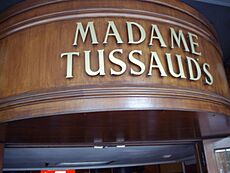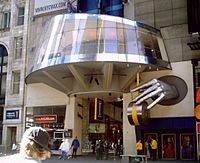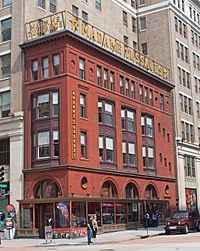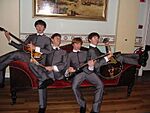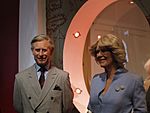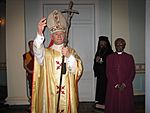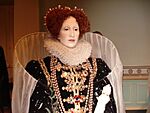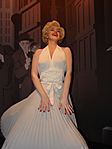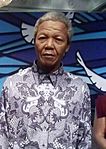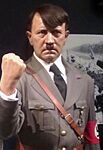Madame Tussauds facts for kids
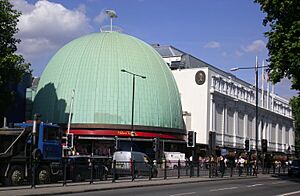
Madame Tussauds has included the former London Planetarium (large dome to the left) since 2010.
|
|
| Established | 22 May 1835 |
|---|---|
| Location | Marylebone Road, City of Westminster, London, England |
| Founder | Marie Tussaud |
Madame Tussauds is a wax museum founded in London in 1835 by the French wax sculptor Marie Tussaud. One of the early main attractions was the Chamber of Horrors, which appeared in advertising in 1843.
In 1883, the restricted space of the original Baker Street site prompted Tussaud's grandson (Joseph Randall) to commission the building at its current London location on Marylebone Road. The new exhibition galleries were opened on 14 July 1884 and were a great success. Madame Tussaud & Sons was incorporated as a private limited company (Ltd.) in 1889.
A major tourist attraction in London since the Victorian era, Madame Tussauds displays the waxworks of famous and historical figures, as well as popular film and television characters played by famous actors. Operated by the British entertainment company Merlin Entertainments, the museum now has locations in cities across four continents, with the first overseas branch opening in Amsterdam in 1970.
Contents
History
Background
Marie Tussaud was born as Marie Grosholtz in 1761 in Strasbourg, France. Her mother worked for Philippe Curtius in Bern, Switzerland; he was a physician skilled in wax modelling. Curtius taught Tussaud the art of wax modelling when she was a child; when he moved to Paris, Marie and her mother followed.
Grosholtz created her first wax sculpture, of Voltaire, in 1777. At 17, according to her memoirs, she became art tutor to Madame Elizabeth, the sister of King Louis XVI. During the French Revolution, she was imprisoned for three months, but was subsequently released. During the Revolution, she made models of many prominent victims.
Grosholtz inherited Curtius' vast collection of wax models following his death in 1794. For the next 33 years, she travelled around Europe with a touring show from the collection. She married Francois Tussaud in 1795, took his surname, and renamed her show as Madame Tussaud's. In 1802 she accepted an invitation from lantern and phantasmagoria pioneer Paul Philidor to exhibit her work alongside his show at the Lyceum Theatre, London. A wave of creativity was in vogue in London when Tussaud arrived in the city, with new West End stage plays which included the first to be called a melodrama, the first appearance of Joseph Grimaldi in his whiteface clown character, and poet William Wordsworth's poem "Composed upon Westminster Bridge, September 3, 1802" describing London and the Thames. Adding her own creativity to the mix, Tussaud brought with her all her death masks, wax faces and busts. Complaining that Philidor failed to promote her, Tussaud then decided to go into business alone.
Unable to return to France because of the Napoleonic Wars, she travelled throughout Great Britain and Ireland exhibiting her collection and made her home in London. From 1831, she took a series of short leases on the upper floor of "Baker Street Bazaar" (on the west side of Baker Street, Dorset Street, and King Street in London). This site was later featured in the Druce-Portland case sequence of trials of 1898–1907. This became Tussaud's first permanent home in 1836.
Origins
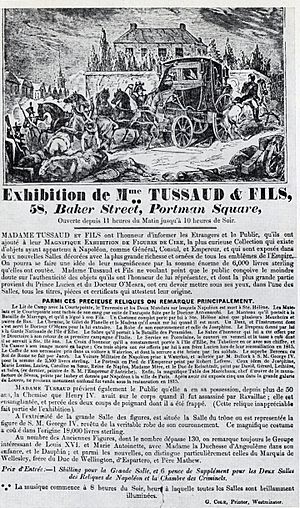
By 1835, Marie Tussaud had settled down in Baker Street and opened a museum. One of her museum's main attractions was the Chamber of Horrors. The name is often credited to a contributor to Punch in 1845, but Tussaud appears to have originated it herself, using it in advertising as early as 1843. This part of the exhibition included victims of the French Revolution and newly created figures of murderers and other criminals. Other famous people were added to the museum, including Lord Nelson, the Duke of Wellington, Henry VIII, and Queen Victoria. The early commercial success of Madame Tussaud's saw it establish itself as a brand, and the museum became a pioneer in innovating various forms of publicity when the advertising industry was in its infancy. The Hall of Fame attraction exerted great influence among the public of Victorian London, and inclusion in it was definitive proof one had attained celebrity status.
In these days no one can be considered properly popular unless he is admitted into the company of Madame Tussaud's celebrities in Baker Street. The only way in which a powerful and lasting impression can be made on the public is through the medium of wax. You must be a doll at Madame Tussaud's before you can become an I-dol(l) of the multitude. Madame Tussaud has become in fact the only dispenser of permanent reputation.
—"The Tussaud Test of Popularity", Punch, 1849.
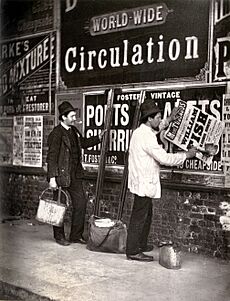
Other businesses in Baker Street profited from being within close proximity to Madame Tussaud's, and in 1860 Charles Dickens hailed the museum as one of London's most popular entertainments, writing in All the Year Round: "Madame Tussaud's is something more than an exhibition, it is an institution." A waxwork of Dickens appeared at the museum in 1873, three years after his death. Some sculptures still exist that were made by Marie Tussaud herself. The gallery originally contained some 400 different figures, but fire damage in 1925 coupled with bombs during the Blitz on London in 1941, severely damaged most of such older models. The casts themselves have survived, allowing the historical waxworks to be remade, and these can be seen in the museum's history exhibit. The oldest figure on display is that of Madame du Barry, the work of Curtius from 1765 and part of the waxworks left to Grosholtz at his death. Other faces from the time of Tussaud include Robespierre and George III. In 1842, she made a self-portrait, which is now on display at the entrance of her museum. She died in her sleep in London on 16 April 1850.
By 1883, the restricted space and rising cost of the Baker Street site prompted her grandson Joseph Randall to commission construction of a building at the museum's current location on Marylebone Road. The new exhibition galleries were opened on 14 July 1884 and were a great success. But Randall had bought out his cousin Louisa's half-share in the business in 1881, and that plus the building costs resulted in his having too little capital. He formed a limited company in 1888 to attract fresh capital but it had to be dissolved after disagreements between the family shareholders. In February 1889 Tussaud's was sold to a group of businessmen led by Edwin Josiah Poyser. Tussaud's great-grandson, John Theodore Tussaud, continued in his role as the museum's manager and chief artist. The first wax sculpture of a young Winston Churchill was made in 1908; a total of ten have been made since. The first overseas branch of Madame Tussauds was opened in Amsterdam in 1970.
Ownership changes
In 2005, Madame Tussauds was sold to a company in Dubai, Dubai International Capital, for £800m (US$1.5bn). In May 2007, The Blackstone Group purchased The Tussauds Group from then-owner Dubai International Capital for US$1.9 billion; the company was merged with Blackstone's Merlin Entertainments and operation of Madame Tussauds was taken over by Merlin. After the Tussauds acquisition, Dubai International Capital gained 20% of Merlin Entertainment.
On 17 July 2007, as part of the financing for the Tussauds deal, Merlin sold the freehold of Madame Tussauds to private investor Nick Leslau and his investment firm Prestbury under a sale and leaseback agreement. Although the attraction sites are owned by Prestbury, they are operated by Merlin based on a renewable 35-year lease.
Recent status
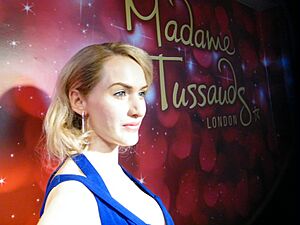
Madame Tussaud's wax museum has been a major tourist attraction in London since it opened in the 1830s, an era viewed as being when the city's tourism industry began. Until 2010, it incorporated the London Planetarium in its west wing. A large animated dark ride, The Spirit of London, opened in 1993. Today's wax figures at Tussauds include historical and royal figures, film stars, sports stars, and famous murderers. It has been known since 2007 as "Madame Tussauds" museums (no apostrophe). In 2009, a 5+1⁄2 inches (14 cm) waxwork of Tinker Bell (the fairy from J. M. Barrie's Peter Pan) became the museum's smallest figure of all time when it was unveiled in London.
In July 2008, Madame Tussauds' Berlin branch became embroiled in controversy when a 41-year-old German man brushed past two guards and decapitated a wax figure depicting Adolf Hitler. This was believed to be an act of protest against showing the ruthless dictator alongside sports heroes, movie stars, and other historical figures. The statue has since been repaired, and the perpetrator has admitted that he attacked the statue to win a bet. The original model of Hitler was unveiled in Madame Tussauds London in April 1933; it was frequently vandalised and a 1936 replacement had to be carefully guarded. In January 2016, the statue of Hitler was removed from the Chamber of Horrors section in the London museum in response to an open letter sent by a staff writer of The Jewish Journal of Greater Los Angeles, followed by significant support for its removal from social media.
The first Madame Tussauds in India opened in New Delhi on 1 December 2017. Its operator, Merlin Entertainments, planned an investment of 50 million pounds over the next 10 years. It features over 50 wax models, including political and entertainment figures such as Ariana Grande, Amitabh Bachchan, Salman Khan, Katrina Kaif, Sachin Tendulkar, Kim Kardashian, Tom Cruise, Leonardo DiCaprio, Scarlett Johansson, Angelina Jolie, Asha Bhosle, Kapil Dev, and Mary Kom. On 30 December 2020, the holding company of Madame Tussauds in Delhi confirmed a temporary shutdown of the museum. It reopened in 2022.
Museum locations
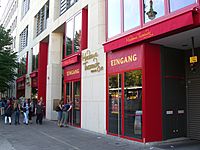
Entry of Madame Tussauds in Berlin
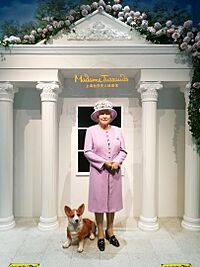
Madame Tussauds in Shanghai, China, displaying a wax figure of Queen Elizabeth II, opened in 2006.
|
Asia
 Beijing, China (2014)
Beijing, China (2014) Chongqing, China (2016)
Chongqing, China (2016) Shanghai, China (2006)
Shanghai, China (2006) Wuhan, China (2013)
Wuhan, China (2013) Hong Kong (2000)
Hong Kong (2000) Delhi, India (2017-2020/2023)
Delhi, India (2017-2020/2023) Tokyo, Japan (2013)
Tokyo, Japan (2013) Singapore (2014)
Singapore (2014) Bangkok, Thailand (2010)
Bangkok, Thailand (2010) Dubai, United Arab Emirates (2021)
Dubai, United Arab Emirates (2021)
Europe
 Amsterdam, Netherlands (1970)
Amsterdam, Netherlands (1970) Berlin, Germany (2008)
Berlin, Germany (2008) Blackpool, United Kingdom (2011)
Blackpool, United Kingdom (2011) Budapest, Hungary (2023)
Budapest, Hungary (2023) Istanbul, Turkey (2016)
Istanbul, Turkey (2016) London, United Kingdom (1835)
London, United Kingdom (1835) Prague, Czech Republic (2019)
Prague, Czech Republic (2019) Vienna, Austria (2011)
Vienna, Austria (2011)
North America
 Hollywood, United States (2009)
Hollywood, United States (2009) Las Vegas, United States (1999)
Las Vegas, United States (1999) Nashville, United States (2017)
Nashville, United States (2017) New York City, United States (2000)
New York City, United States (2000) Orlando, United States (2015)
Orlando, United States (2015) San Francisco, United States (2014)
San Francisco, United States (2014) Washington, D.C., United States (2007–2021)
Washington, D.C., United States (2007–2021)
Oceania
 Sydney, Australia (2012)
Sydney, Australia (2012)
List of wax figures
Gallery
-
Madame Tussaud herself at Madame Tussauds in London. Her death mask is visible in the background on the left.
-
King Charles III and Queen Camilla
-
Johnny Depp as Jack Sparrow
-
Adolf Hitler (formerly in the Chamber of Horrors section in London)
See also
 In Spanish: Museo Madame Tussauds para niños
In Spanish: Museo Madame Tussauds para niños
- Madame Tussauds Amsterdam
- Madame Tussauds Bangkok
- Madame Tussauds Beijing
- Madame Tussauds Blackpool
- Madame Tussauds Delhi
- Madame Tussauds Dubai
- Madame Tussauds Hollywood
- Madame Tussauds Hong Kong
- Madame Tussauds Istanbul
- Madame Tussauds Las Vegas
- Madame Tussauds Nashville
- Madame Tussauds New York
- Madame Tussauds Orlando
- Madame Tussauds Rock Circus (1989–2001, London)
- Madame Tussauds San Francisco
- Madame Tussauds Shanghai
- Madame Tussauds Singapore
- Madame Tussauds Sydney
- Madame Tussauds Tokyo
- Madame Tussauds Vienna
- Madame Tussauds Washington D.C.




